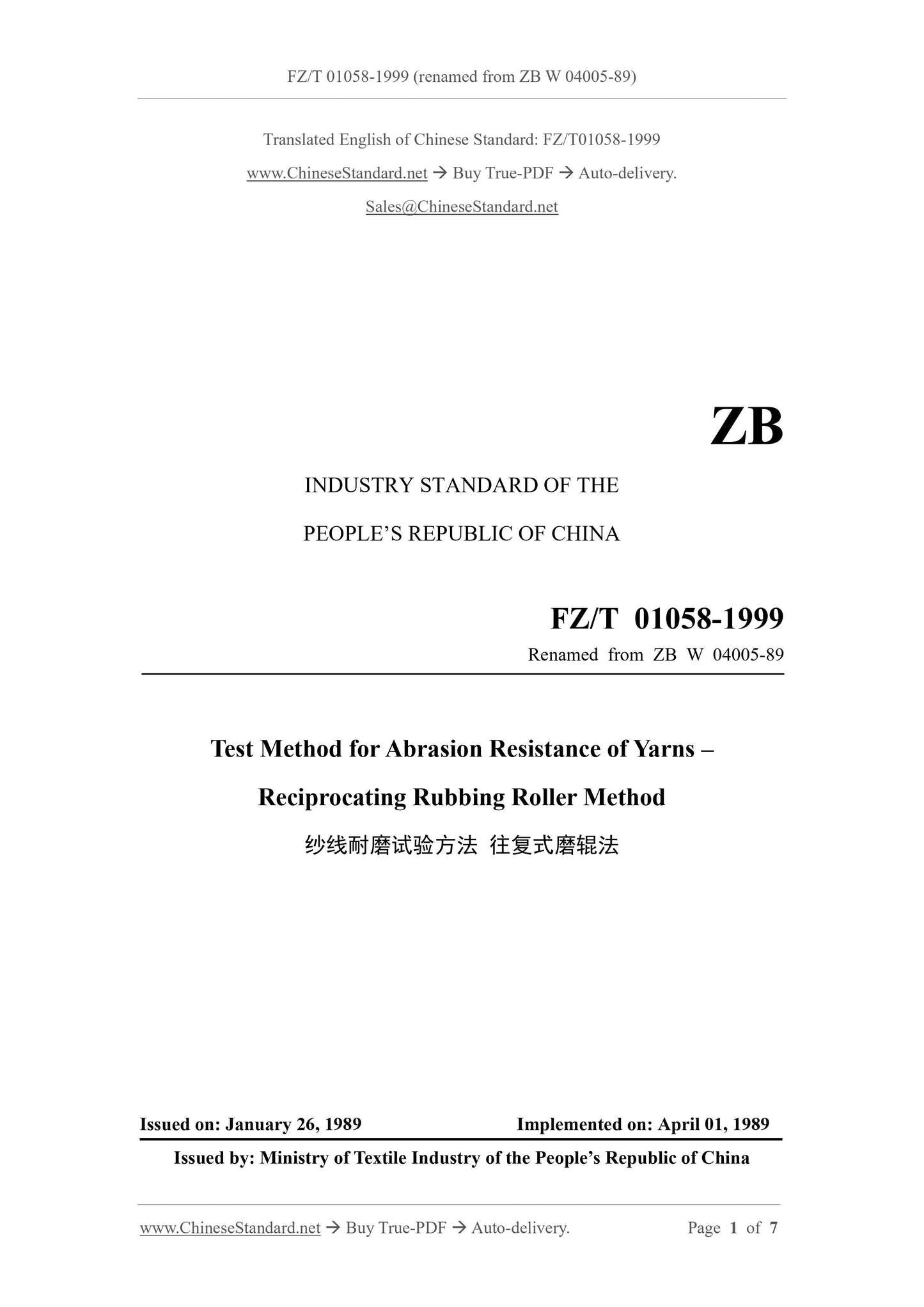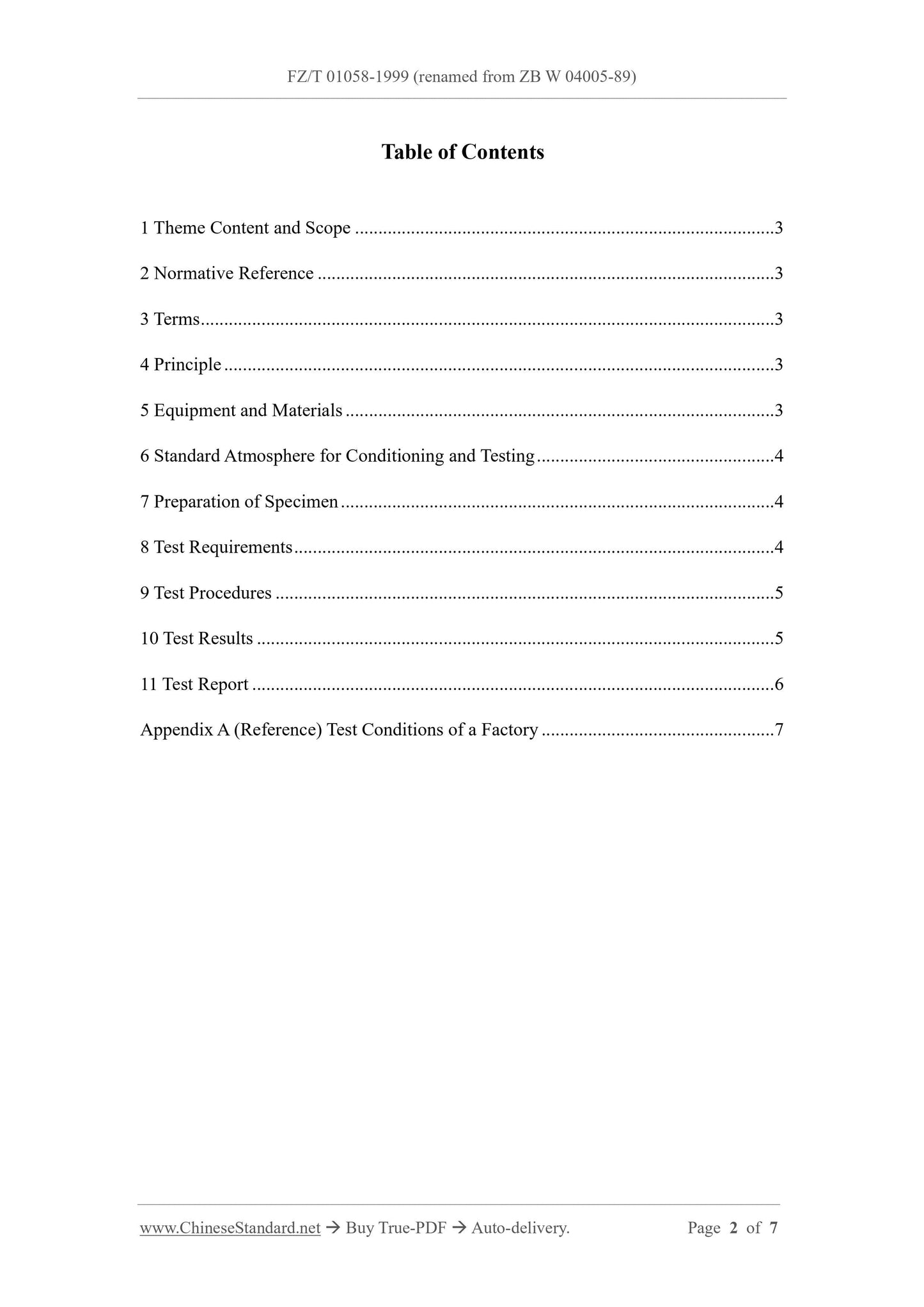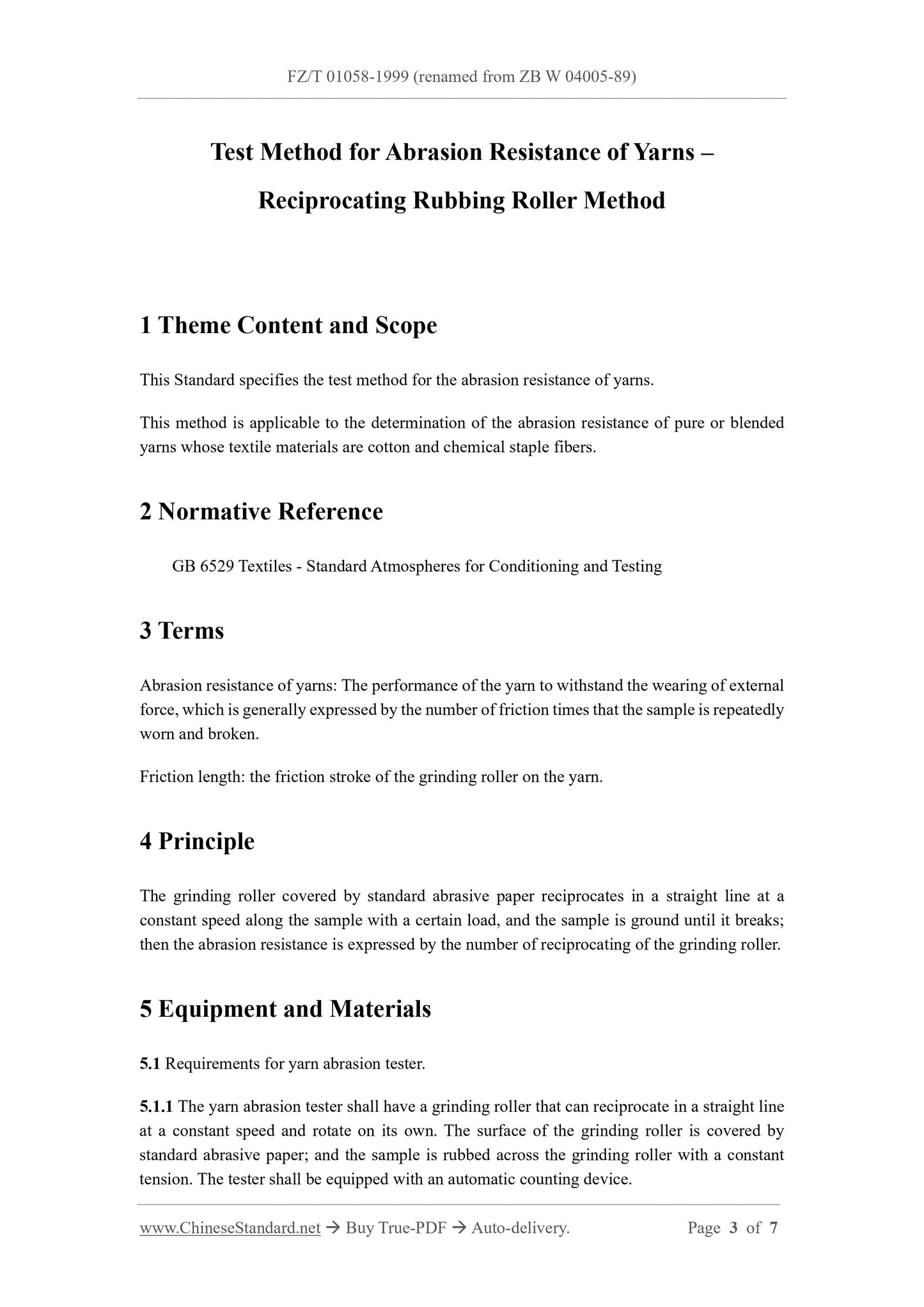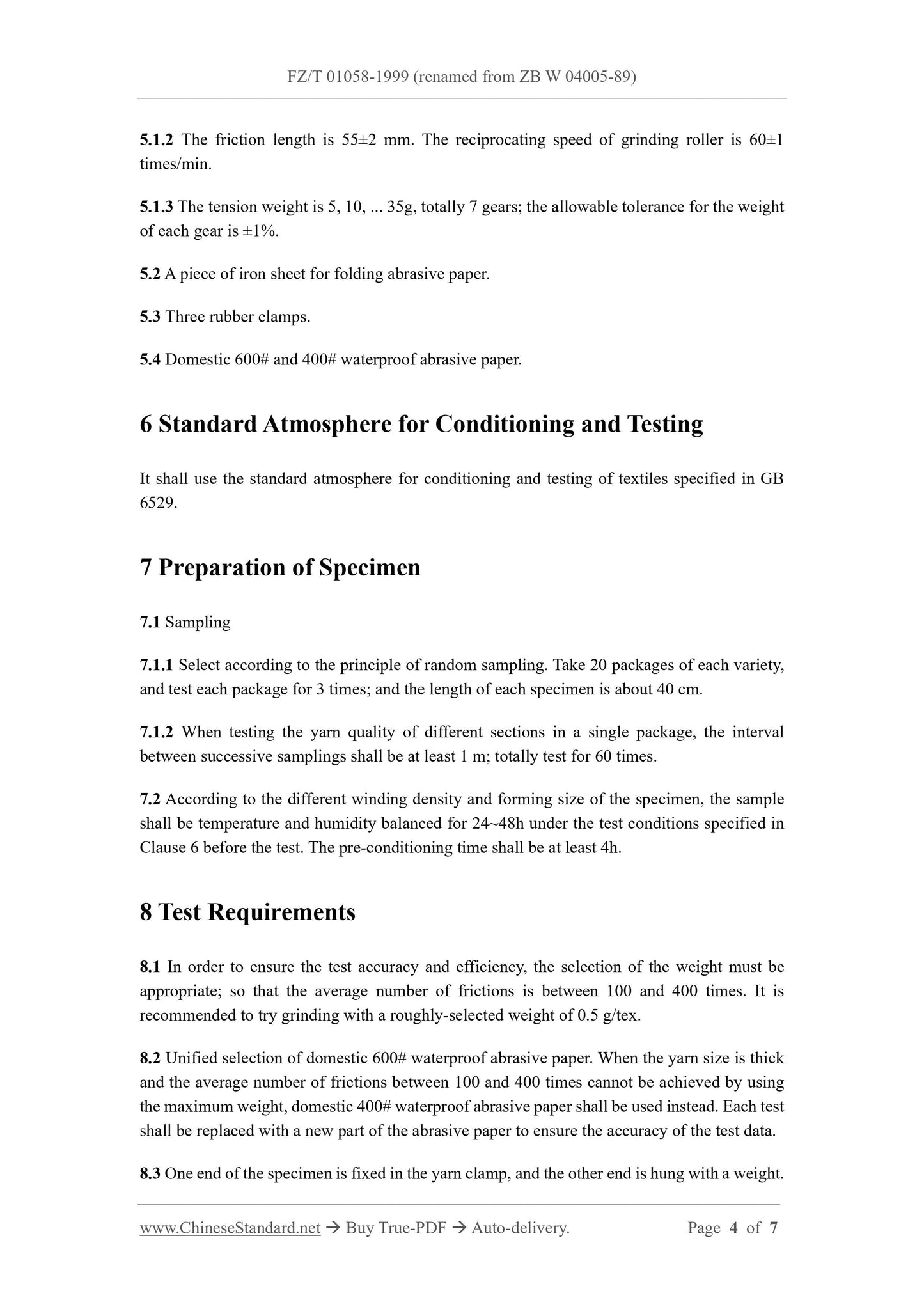1
/
の
4
PayPal, credit cards. Download editable-PDF and invoice in 1 second!
FZ/T 01058-1999 English PDF (FZT01058-1999)
FZ/T 01058-1999 English PDF (FZT01058-1999)
通常価格
$190.00 USD
通常価格
セール価格
$190.00 USD
単価
/
あたり
配送料はチェックアウト時に計算されます。
受取状況を読み込めませんでした
Delivery: 3 seconds. Download true-PDF + Invoice.
Get QUOTATION in 1-minute: Click FZ/T 01058-1999
Historical versions: FZ/T 01058-1999
Preview True-PDF (Reload/Scroll if blank)
FZ/T 01058-1999: Test method for abrasion resistance of yarns. Reciprocating rubbing roller method
FZ/T 01058-1999 (renamed from ZB W 04005-89)
INDUSTRY STANDARD OF THE
PEOPLE’S REPUBLIC OF CHINA
FZ/T 01058-1999
Renamed from ZB W 04005-89
Test Method for Abrasion Resistance of Yarns –
Reciprocating Rubbing Roller Method
ISSUED ON: JANUARY 26, 1989
IMPLEMENTED ON: APRIL 01, 1989
Issued by: Ministry of Textile Industry of the People’s Republic of China
Table of Contents
1 Theme Content and Scope ... 3
2 Normative Reference ... 3
3 Terms ... 3
4 Principle ... 3
5 Equipment and Materials ... 3
6 Standard Atmosphere for Conditioning and Testing ... 4
7 Preparation of Specimen ... 4
8 Test Requirements ... 4
9 Test Procedures ... 5
10 Test Results ... 5
11 Test Report ... 6
Appendix A (Reference) Test Conditions of a Factory ... 7
Test Method for Abrasion Resistance of Yarns –
Reciprocating Rubbing Roller Method
1 Theme Content and Scope
This Standard specifies the test method for the abrasion resistance of yarns.
This method is applicable to the determination of the abrasion resistance of pure or blended
yarns whose textile materials are cotton and chemical staple fibers.
2 Normative Reference
GB 6529 Textiles - Standard Atmospheres for Conditioning and Testing
3 Terms
Abrasion resistance of yarns: The performance of the yarn to withstand the wearing of external
force, which is generally expressed by the number of friction times that the sample is repeatedly
worn and broken.
Friction length: the friction stroke of the grinding roller on the yarn.
4 Principle
The grinding roller covered by standard abrasive paper reciprocates in a straight line at a
constant speed along the sample with a certain load, and the sample is ground until it breaks;
then the abrasion resistance is expressed by the number of reciprocating of the grinding roller.
5 Equipment and Materials
5.1 Requirements for yarn abrasion tester.
5.1.1 The yarn abrasion tester shall have a grinding roller that can reciprocate in a straight line
at a constant speed and rotate on its own. The surface of the grinding roller is covered by
standard abrasive paper; and the sample is rubbed across the grinding roller with a constant
tension. The tester shall be equipped with an automatic counting device.
5.1.2 The friction length is 55±2 mm. The reciprocating speed of grinding roller is 60±1
times/min.
5.1.3 The tension weight is 5, 10, ... 35g, totally 7 gears; the allowable tolerance for the weight
of each gear is ±1%.
5.2 A piece of iron sheet for folding abrasive paper.
5.3 Three rubber clamps.
5.4 Domestic 600# and 400# waterproof abrasive paper.
6 Standard Atmosphere for Conditioning and Testing
It shall use the standard atmosphere for conditioning and testing of textiles specified in GB
6529.
7 Preparation of Specimen
7.1 Sampling
7.1.1 Select according to the principle of random sampling. Take 20 packages of each variety,
and test each package for 3 times; and the length of each specimen is about 40 cm.
7.1.2 When testing the yarn quality of different sections in a single package, the interval
between successive samplings shall be at least 1 m; totally test for 60 times.
7.2 According to the different winding density and forming size of the specimen, the sample
shall be temperature and humidity balanced for 24~48h under the test conditions specified in
Clause 6 before the test. The pre-conditioning time shall be at least 4h.
8 Test Requirements
8.1 In order to ensure the test accuracy and efficiency, the selection of the weight must be
appropriate; so that the average number of frictions is between 100 and 400 times. It is
recommended to try grinding with a roughly-selected weight of 0.5 g/tex.
8.2 Unified selection of domestic 600# waterproof abrasive paper. When the yarn size is thick
and the average number of frictions between 100 and 400 times cannot be achieved by using
the maximum weight, domestic 400# waterproof abrasive paper shall be used instead. Each test
shall be replaced with a new part of the abrasive paper to ensure the accuracy of the test data.
8.3 One end of the specimen is fixed in the yarn clamp, and the other end is hung with a weight.
Get QUOTATION in 1-minute: Click FZ/T 01058-1999
Historical versions: FZ/T 01058-1999
Preview True-PDF (Reload/Scroll if blank)
FZ/T 01058-1999: Test method for abrasion resistance of yarns. Reciprocating rubbing roller method
FZ/T 01058-1999 (renamed from ZB W 04005-89)
INDUSTRY STANDARD OF THE
PEOPLE’S REPUBLIC OF CHINA
FZ/T 01058-1999
Renamed from ZB W 04005-89
Test Method for Abrasion Resistance of Yarns –
Reciprocating Rubbing Roller Method
ISSUED ON: JANUARY 26, 1989
IMPLEMENTED ON: APRIL 01, 1989
Issued by: Ministry of Textile Industry of the People’s Republic of China
Table of Contents
1 Theme Content and Scope ... 3
2 Normative Reference ... 3
3 Terms ... 3
4 Principle ... 3
5 Equipment and Materials ... 3
6 Standard Atmosphere for Conditioning and Testing ... 4
7 Preparation of Specimen ... 4
8 Test Requirements ... 4
9 Test Procedures ... 5
10 Test Results ... 5
11 Test Report ... 6
Appendix A (Reference) Test Conditions of a Factory ... 7
Test Method for Abrasion Resistance of Yarns –
Reciprocating Rubbing Roller Method
1 Theme Content and Scope
This Standard specifies the test method for the abrasion resistance of yarns.
This method is applicable to the determination of the abrasion resistance of pure or blended
yarns whose textile materials are cotton and chemical staple fibers.
2 Normative Reference
GB 6529 Textiles - Standard Atmospheres for Conditioning and Testing
3 Terms
Abrasion resistance of yarns: The performance of the yarn to withstand the wearing of external
force, which is generally expressed by the number of friction times that the sample is repeatedly
worn and broken.
Friction length: the friction stroke of the grinding roller on the yarn.
4 Principle
The grinding roller covered by standard abrasive paper reciprocates in a straight line at a
constant speed along the sample with a certain load, and the sample is ground until it breaks;
then the abrasion resistance is expressed by the number of reciprocating of the grinding roller.
5 Equipment and Materials
5.1 Requirements for yarn abrasion tester.
5.1.1 The yarn abrasion tester shall have a grinding roller that can reciprocate in a straight line
at a constant speed and rotate on its own. The surface of the grinding roller is covered by
standard abrasive paper; and the sample is rubbed across the grinding roller with a constant
tension. The tester shall be equipped with an automatic counting device.
5.1.2 The friction length is 55±2 mm. The reciprocating speed of grinding roller is 60±1
times/min.
5.1.3 The tension weight is 5, 10, ... 35g, totally 7 gears; the allowable tolerance for the weight
of each gear is ±1%.
5.2 A piece of iron sheet for folding abrasive paper.
5.3 Three rubber clamps.
5.4 Domestic 600# and 400# waterproof abrasive paper.
6 Standard Atmosphere for Conditioning and Testing
It shall use the standard atmosphere for conditioning and testing of textiles specified in GB
6529.
7 Preparation of Specimen
7.1 Sampling
7.1.1 Select according to the principle of random sampling. Take 20 packages of each variety,
and test each package for 3 times; and the length of each specimen is about 40 cm.
7.1.2 When testing the yarn quality of different sections in a single package, the interval
between successive samplings shall be at least 1 m; totally test for 60 times.
7.2 According to the different winding density and forming size of the specimen, the sample
shall be temperature and humidity balanced for 24~48h under the test conditions specified in
Clause 6 before the test. The pre-conditioning time shall be at least 4h.
8 Test Requirements
8.1 In order to ensure the test accuracy and efficiency, the selection of the weight must be
appropriate; so that the average number of frictions is between 100 and 400 times. It is
recommended to try grinding with a roughly-selected weight of 0.5 g/tex.
8.2 Unified selection of domestic 600# waterproof abrasive paper. When the yarn size is thick
and the average number of frictions between 100 and 400 times cannot be achieved by using
the maximum weight, domestic 400# waterproof abrasive paper shall be used instead. Each test
shall be replaced with a new part of the abrasive paper to ensure the accuracy of the test data.
8.3 One end of the specimen is fixed in the yarn clamp, and the other end is hung with a weight.
Share








